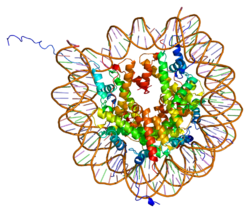Histone H4 is a protein that, in humans, is encoded by the HIST1H4I gene.[5][6][7][8]
Histones are basic nuclear proteins that are responsible for the nucleosome structure of the chromosomal fiber in eukaryotes. Two molecules of each of the four core histones (H2A, H2B, H3, and H4) form an octamer, around which approximately 146 bp of DNA is wrapped in repeating units, called nucleosomes. The linker histone, H1, interacts with linker DNA between nucleosomes and functions in the compaction of chromatin into higher order structures. This gene is intronless and encodes a member of the histone H4 family. Transcripts from this gene lack polyA tails but instead contain a palindromic termination element. This gene is found in the histone microcluster on chromosome 6p21.33.[8]
References
edit- ^ a b c GRCh38: Ensembl release 89: ENSG00000276180 – Ensembl, May 2017
- ^ a b c GRCm38: Ensembl release 89: ENSMUSG00000060981 – Ensembl, May 2017
- ^ "Human PubMed Reference:". National Center for Biotechnology Information, U.S. National Library of Medicine.
- ^ "Mouse PubMed Reference:". National Center for Biotechnology Information, U.S. National Library of Medicine.
- ^ Akasaka T, Miura I, Takahashi N, Akasaka H, Yonetani N, Ohno H, et al. (Jan 1997). "A recurring translocation, t(3;6)(q27;p21), in non-Hodgkin's lymphoma results in replacement of the 5' regulatory region of BCL6 with a novel H4 histone gene". Cancer Res. 57 (1): 7–12. PMID 8988030.
- ^ Albig W, Doenecke D (Feb 1998). "The human histone gene cluster at the D6S105 locus". Hum Genet. 101 (3): 284–94. doi:10.1007/s004390050630. PMID 9439656. S2CID 38539096.
- ^ Marzluff WF, Gongidi P, Woods KR, Jin J, Maltais LJ (Oct 2002). "The human and mouse replication-dependent histone genes". Genomics. 80 (5): 487–98. doi:10.1016/S0888-7543(02)96850-3. PMID 12408966.
- ^ a b "Entrez Gene: HIST1H4I histone cluster 1, H4i".
Further reading
edit- Albig W, Kardalinou E, Drabent B, Zimmer A, Doenecke D (1991). "Isolation and characterization of two human H1 histone genes within clusters of core histone genes". Genomics. 10 (4): 940–8. doi:10.1016/0888-7543(91)90183-F. PMID 1916825.
- Turner BM, O'Neill LP, Allan IM (1989). "Histone H4 acetylation in human cells. Frequency of acetylation at different sites defined by immunolabeling with site-specific antibodies". FEBS Lett. 253 (1–2): 141–5. Bibcode:1989FEBSL.253..141T. doi:10.1016/0014-5793(89)80947-0. PMID 2474456. S2CID 42476424.
- Pauli U, Chrysogelos S, Stein G, Stein J, Nick H (1987). "Protein-DNA interactions in vivo upstream of a cell cycle-regulated human H4 histone gene". Science. 236 (4806): 1308–11. Bibcode:1987Sci...236.1308P. doi:10.1126/science.3035717. PMID 3035717.
- Ebralidse KK, Grachev SA, Mirzabekov AD (1988). "A highly basic histone H4 domain bound to the sharply bent region of nucleosomal DNA". Nature. 331 (6154): 365–7. Bibcode:1988Natur.331..365E. doi:10.1038/331365a0. PMID 3340182. S2CID 4351515.
- Sierra F, Stein G, Stein J (1983). "Structure and in vitro transcription of a human H4 histone gene". Nucleic Acids Res. 11 (20): 7069–86. doi:10.1093/nar/11.20.7069. PMC 326439. PMID 6314274.
- Drabent B, Kardalinou E, Bode C, Doenecke D (1995). "Association of histone H4 genes with the mammalian testis-specific H1t histone gene". DNA Cell Biol. 14 (7): 591–7. doi:10.1089/dna.1995.14.591. PMID 7626218.
- Albig W, Meergans T, Doenecke D (1997). "Characterization of the H1.5 gene completes the set of human H1 subtype genes". Gene. 184 (2): 141–8. doi:10.1016/S0378-1119(96)00582-3. PMID 9031620.
- Albig W, Kioschis P, Poustka A, Meergans K, Doenecke D (1997). "Human histone gene organization: nonregular arrangement within a large cluster". Genomics. 40 (2): 314–22. doi:10.1006/geno.1996.4592. PMID 9119399.
- El Kharroubi A, Piras G, Zensen R, Martin MA (1998). "Transcriptional Activation of the Integrated Chromatin-Associated Human Immunodeficiency Virus Type 1 Promoter". Mol. Cell. Biol. 18 (5): 2535–44. doi:10.1128/mcb.18.5.2535. PMC 110633. PMID 9566873.
- Albig W, Trappe R, Kardalinou E, Eick S, Doenecke D (1999). "The human H2A and H2B histone gene complement". Biol. Chem. 380 (1): 7–18. doi:10.1515/BC.1999.002. PMID 10064132. S2CID 12807248.
- Ahn J, Gruen JR (1999). "The genomic organization of the histone clusters on human 6p21.3". Mamm. Genome. 10 (7): 768–70. doi:10.1007/s003359901089. PMID 10384058. S2CID 28275496.
- Deng L, de la Fuente C, Fu P, Wang L, Donnelly R, Wade JD, et al. (2001). "Acetylation of HIV-1 Tat by CBP/P300 increases transcription of integrated HIV-1 genome and enhances binding to core histones". Virology. 277 (2): 278–95. doi:10.1006/viro.2000.0593. PMID 11080476.
- Deng L, Wang D, de la Fuente C, Wang L, Li H, Lee CG, et al. (2001). "Enhancement of the p300 HAT activity by HIV-1 Tat on chromatin DNA". Virology. 289 (2): 312–26. doi:10.1006/viro.2001.1129. PMID 11689053.
- Strausberg RL, Feingold EA, Grouse LH, Derge JG, Klausner RD, Collins FS, et al. (2003). "Generation and initial analysis of more than 15,000 full-length human and mouse cDNA sequences". Proc. Natl. Acad. Sci. U.S.A. 99 (26): 16899–903. Bibcode:2002PNAS...9916899M. doi:10.1073/pnas.242603899. PMC 139241. PMID 12477932.
- Mungall AJ, Palmer SA, Sims SK, Edwards CA, Ashurst JL, Wilming L, et al. (2003). "The DNA sequence and analysis of human chromosome 6". Nature. 425 (6960): 805–11. doi:10.1038/nature02055. PMID 14574404.
- Lusic M, Marcello A, Cereseto A, Giacca M (2004). "Regulation of HIV-1 gene expression by histone acetylation and factor recruitment at the LTR promoter". EMBO J. 22 (24): 6550–61. doi:10.1093/emboj/cdg631. PMC 291826. PMID 14657027.
- Bouwmeester T, Bauch A, Ruffner H, Angrand PO, Bergamini G, Croughton K, et al. (2004). "A physical and functional map of the human TNF-alpha/NF-kappa B signal transduction pathway". Nat. Cell Biol. 6 (2): 97–105. doi:10.1038/ncb1086. PMID 14743216. S2CID 11683986.




